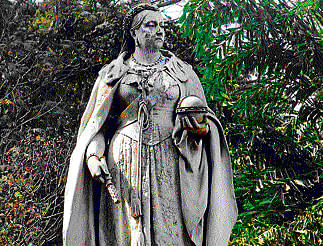
The statue of Queen Victoria, which was officially unveiled on February 5, 1906 by the then Prince of Wales, turns 107 today. Of the more than 50 statues of Victoria that were installed in India, only five still remain at their original locations. Bangalore’s statue is one of them, observes Meera Iyer
A relic of our colonial past turns 107 today. The statue of Queen Victoria in Bangalore was officially unveiled on February 5, 1906 in a ceremony filled with much fanfare and oratory. The then Prince of Wales, George Frederick Ernest Albert (later King George V), did the honours. By then, the Prince was a veteran in this sort of thing, having already unveiled a Victoria statue in Agra, Victoria memorials in Calcutta and Rangoon, and a Victoria Technical Institute in Madras in just the first three months of his India tour. From Bangalore, the Prince’s tour took him to Karachi, where he was to unveil yet another statue of the late queen empress.
Nevertheless, in his speech, the Prince alluded to something about the Bangalore statue that he said gave him ‘especial pleasure’: “It is the association of the Maharaja of Mysore and his people with the inhabitants of the Civil and Military station of Bangalore”. The Prince was referring to the fact that the statue would not have been erected at all but for a generous contribution from the Maharaja.
From 1876, Victoria had ruled from afar as Empress of India. Soon after her death in January 1901, committees sprang up all over India and elsewhere in her dominions, to deliberate on ways to commemorate the haughty queen’s memory. Bangalore’s Queen Victoria Memorial Fund met a little over a year after the queen died, to mull over the matter. After vacillating between a technical institute in her name and a statue, it was finally decided to commission a statue. The memorial was to be funded by public subscription. But after six months of fund-raising, the public had only contributed Rs 10,000. In the end, it was a generous donation from the Maharaja of Mysore, Krishnaraja Wodeyar IV, which finally ensured that the statue project didn’t die an early death.
The task of making the statue was given to Thomas Brock, a prolific and celebrated sculptor in England whose most famous work was the Victoria Memorial in front of the Buckingham Palace in London. Brock made an 11-foot-tall marble statue for Bangalore, which, together with its 13-foot granite pedestal, cost Rs 25,500. It was shipped here from England and arrived in July 1905.
At the same time that Bangalore’s Victoria memorial committee commissioned a statue from him, Brock also had orders for statues of the empress from Agra, Kanpur and Lucknow! Bangalore’s statue is a copy of an earlier one that Brock had made for his home town of Worcester in England in 1890. It was quite a popular prototype, another replica of it was requested for the city of Birmingham. In all, Brock made 14 Victoria statues during his career. Statues made by him that are similar to Bangalore’s statue still stand in cities around the world including Carlisle and Hove (both in England), Belfast, Cape Town, Brisbane and London. Bangaloreans would instantly recognise these statues all of which have the queen dressed in her flowing Order of the Garter robes decorated with roses and tassels, and carrying a sceptre and an orb. Other details vary, like the tilt of the monarch’s head and the angle at which she looks down her nose.
Of the more than 50 statues of Victoria that were installed in India, only five still remain at their original locations. Bangalore’s statue is one of them.
The empress’s regalia are somewhat battered now. Her sovereign’s orb lost its cross many years ago and her sceptre too lies broken, along with a finger in her right hand. Early photographs show the statue encircled with ornamental chains, and a soldier and two cannons standing guard. But our colonial past is behind us and so, fittingly, this imperial symbol no longer occupies pride of place. Though it is still tended to, the queen’s statue stands encircled and almost obscured by lush green trees.